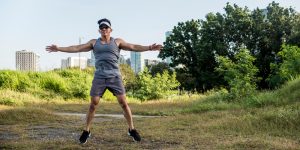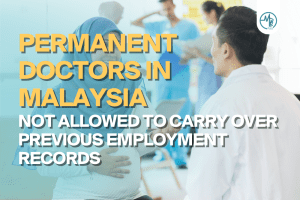Doctor On Call, or DOC for short, is a brand new series brought to you by Medical Channel Asia. This series aims to bring doctors and specialists from various fields to give you an introduction to common health and medical topics that you and the Asian population are interested in. In our 5th DOC, held on 13 Oct (Wednesday), from 8pm to 9pm (GMT+8), we have Dr Jade Kua, Senior Consultant, Emergency Medicine with Woodlands Health Campus (WHC), to talk to us about DARE to Save a Heart: How to use an automated external defibrillator (AED) to save someone in cardiac arrest.
This 3-part cardiology webinar series aims to educate the Asian population on the different aspects of cardiac conditions, ranging from the risk factors of heart diseases, to the most current updates on CPR, and the types of treatment options available after a heart attack.
For Part 1 of the forum, we have Dr Jade give us a short presentation on the DARE programme. In Part 2, Dr Jade answers some of the questions posted by our audience, both collated from the registration process, and also posted LIVE. Read below to find out the answers to some of these questions that may apply to you or your loved ones as well!
Question and Answer – Pre-collated segment
Q1: What’s the difference between CPR and AED?
Dr Jade: CPR stands for cardiopulmonary resuscitation. Cardio refers to the heart, pulmonary refers to the lungs, and resuscitation refers to bringing someone back to life. That refers to the hands-only chest compression – pumping the heart that has previously stop, so you can circulate the oxygen around the body.
AED stands for automated external defibrillator. It is a clever machine meant for lay people to deliver an electrical shock through the victim’s body to restart their heart.
Both are important when a patient has a cardiac arrest. Although they are different processes, the early usages of these processes in combination can greatly help a patient to survive.
Q2: Are there certain situations whereby you cannot use an AED to save someone?
Dr Jade: Super good question. In a situation when a person has collapsed, the first thing you are going to do is to call 995. The dispatcher will have to figure out what is wrong: has the patient fainted? Did the patient not have enough food? Is the patient having a nap?
The dispatcher is going to ask you 2 questions:
- Is this victim responsive? If patient is responsive, he will not tell you to use an AED. If the patient is not responsive, it is likely going to be a big alert.
- Is the victim breathing? The patient could be not breathing at all, or not breathing normally (e.g. gasping for air). The dispatcher is likely to get you to start CPR and use an AED.
When you use an AED, you are going to be switching the machine on, and put the pads on the patient. Then you will simply wait for the AED to give an instruction. The AED will read the rhythm of the heart, and if shock is not required, you will just continue chest compression. If shock is required, it will ask you to do that and it will be obvious which button to press. After shock is delivered, you are expected to continue chest compression for 2 minutes, and then the AED will determine is shock is required again.
So short answer: you can attach the AED to anybody, the AED will then determine if the patient need a shock or not. So do not be worried about bringing the AED to the victim, switching it on, and putting the pads on. If the patient does not require a shock, it will not deliver it to the victim.
Q3: My echocardiogram and ECG were normal. However, upon checking my angiogram, there was a 90% blockage. How accurate is echo and ECG in determining heart diseases?
Dr Jade: This is also the reason why we recommend different screening methods for people of different age groups or tiers. The different methods look at different parts of the heart. An echo can show you what your heart roughly looks like, the contractility, pump, flow rates and valves. The ECG just looks at the electrical rhythm of the heart. If you have a heart attack right now, the ECG will likely be able to show. However, if you have a 90% blockage on angiogram, but if the electrical rhythm may still remain normal as you are not having a heart attack (as a result of those blockage). This will lead to your ECG showing to be normal.
It might look less normal if you are doing a stress ECG, or if you were feeling chest pains throughout the day and you are using a 24-hour Holter (which measures your electrical rhythm for 24 hours). But most of the time, the ECG is done at a snapshot (at that point in time), and hence we need to take into context at how that person is feeling. We also do blood tests and look at cardiac enzymes.
In summary, these are 3 completely different modalities. A person may have a 90% blockage on angiogram detected upon screening without any symptoms. The advantage is that you will have time to plan what to do. For example you can plan for a stent a few months in advance. However, if you had the angiogram done because of an emergency such as heart pain, then you may be doing the stent in an emergency setting.
The blockage in the angiogram is often associated with older people, males, smoking history, diabetes, high blood pressure etc. That is one of the very common things that lead to heart attacks. However, you can have fit, young lady without the above risk factors developing heart attack. This is usually not due to blockage, but likely due to disturbances in heart rhythm. In both situations, CPR and defibrillators are helpful. But particularly in this population, using CPR and AED is the only way to save them, because they did not need any blood vessels to be unblocked to begin with.
Q4: How do you tell the difference between a fainting spell, stroke and cardiac arrest when someone passes out? When do I know to use the AED?
Dr Jade: These instances may present similarly – where a person may faint or be presented with a fainting spell. Sometimes it may be difficult to differentiate between these.
To find out the differences, you tap them firmly on their shoulders and see if they can be roused. If they can be, then they are considered to be responsive, and the chance of cardiac arrest is quite low. If they are not responsive, the dispatcher will get you to check if they are breathing normally. In the event that the patient is not breathing normally or not breathing at all, their chance of cardiac arrest is very high, and they will get you to start CPR.
By using an AED, you will also be able to tell if defibrillation is required. You can put the defibrillation on any of these patients, and if shock is not required, the AED will not tell you to shock the patient. You can use the AED on all of these patients if you are not sure. But the dispatcher will likely recommend you to use an AED for someone with a cardiac arrest rather than someone with a stroke (which are likely to be responding differently: droopy face, weak arms, unable to move legs). For fainting spells, the patient is likely to still be able to breathe normally, as the heart is still pumping.
Q5: What if there is no AED nearby? Is it a necessary life-saving device? Will a person die with this shock?
Dr Jade: An AED can help greatly. Recap the statistics in my early presentation, the chance of survival is boosted greatly when you use early defibrillation on top of early CPR. Particularly in the situation where it is an electrical disturbance, the AED is very helpful.
If there is no AED nearby, you should just continue doing CPR till the ambulance arrive. If there is an AED nearby, do not hesitate and do not be afraid to use it. You can find AEDs in many places in Singapore, such as public transport, schools, and even hospitals! It is so important and hence we want to provide the hardware at so many places to be able to help people to save people.
Without the shock, the chances of survival (if needed) is definitely lower, and hence I encourage people to learn and how to use it.
Question and Answer – LIVE
Q1: What do I need to do if someone at home experiences a stroke or a cardiac arrest?
Dr Jade: In both of these situations, they are time-sensitive. It is important to recognise that this person is having a stroke or a cardiac emergency. Once you recognise that the person is having a stroke (i.e. dropping face, feeling weak, bad headache), or a cardiac arrest (looking pale, unable to breathe, collapse), the most important thing is to get medical help.
Once you call for help, the ambulance is going to come to you. For time-sensitive emergencies, fire-bikers may be dispatched which can arrive in 4 to 6 mins (in Singapore’s context). Hence you are pretty much on your own for 4 to 6 mins. Stay on the line to listen to instructions from the dispatcher on what you should do. If it is a heart emergency, you will be tasked to start CPR, and have someone to get an AED if available. The earlier you give the shock (if the person needs it), the better. Don’t wait for the ambulance.
Q2: How does one person do CPR on the elderly, without worrying about crushing the chest or rib bones?
Dr Jade: The priority is to pump the blood hard and fast. Even if you were to break the ribs, it is not as worrisome to the person dying or having poor neurological outcomes.
If you do feel the person’s bones have broken, simply shift your hands slightly and continue the CPR. The dispatcher will be able to assist you as well, if you happen to hear a crack. It is okay and common for people who are very old or very weak bones.
The bigger problem is actually people not pushing hard enough instead of breaking the bones.
The other perspective is that when the person is recovering in the hospital, he/she will not blame you for breaking their bones, but will instead thank you for saving their lives. Most of these rib fractures are usually isolated, and do not require surgery. Simply take painkillers, get mobile early to prevent other complications like chest infections.
If there is no life saved, there is no recovery to speak of. The priority is always to save the lives and preserve the neurological outcomes.
Q3: Can an AED be used on a pregnant woman?
Dr Jade: The priority is to save the mother. If the mother is not saved, the baby has a very high chance of not making it as well. We would want to save the mother. Work on her as thought you are saving only one person, do not worry that the shock from the AED is going to be too much for the baby. If the mother survives with good neurological outcomes, the baby is likely to survive as well.
You are going to be on the line with the dispatcher, so if you have problems like sticking the patch on the mother, tell them your concerns, and they can help you.
But the principles remain the same: early CPR and early defibrillation is more likely to save the patient, and more likely to save the baby as well.
Q4: Is any special training required to use an AED?
Dr Jade: You don’t have to attend special training to use the AED, as it is easy to identify and use. They are widely available in many places (shopping malls, housing estates etc.), and easily recognisable. You would not be identifying it incorrectly.
The instructions and buttons to press are also very obvious. Once you switch it on, the verbal instructions and visual cues will be very obvious as well. Once you listen to it, it will tell you whether to deliver the shock or not. Hence you do not need special training, a lay person can do it. Pre-schoolers are also able to do it!
But going for trainings and webinars like this, or the DARE session, or the formal courses, will help you familiarise with the AED. This can help you be less anxious when you use the AED machine, and be more likely to put the patches more easily.
Q5: Who is at risk of cardiac arrest?
Dr Jade: We typically associate cardiac arrest with the following:
These populations are usually the ones with heart blockages who put them at risk of cardiac arrest.
But cardiac arrest can also be due to other things such as electrical disturbances in the heart, which can happen to very young and fit people without previous illnesses. It may be due to this electrical disturbances being undiagnosed.
Anybody can suffer from cardiac arrest, and hence it is important that all of us learn what to do to be there for each other.
Q6: What if the child collapse? Can they still use the AED found in the public?
Dr Jade: When the child collapse, the CPR methods will change slightly. Listen to the dispatcher for the specific instructions. For example, the chest compressions depth and compression strength may differ.
Children may die from respiratory arrest as well, hence mouth-to-mouth ventilation is crucial as well (as compared to the adult). The dispatcher will guide you along.
I recommend for parents with children suffering from cardiac abnormalities to go for certification courses, so that they do not panic when cardiac arrest happens.
With respect to AEDs, the public AED is likely to come with different sizes of pads, which can deliver a weaker shock. If for some reason there were no child pads or no button specific for children, remember simply speak to the dispatcher and listen for instructions, and not to worry.
Q7: Can we teach children how to use an AED?
Dr Jade: Definitely! We teach AEDs to all types of students. It is also safe for them to use, as it is about listening to instructions: how to apply the pads, and when to have your hands off so you do not accidentally get electrocuted as the rescuer.
Sometimes it is important to have that extra pair of hands as well, because your CPR is supposed to be continuous. With an extra pair of hands, CPR can be continued when someone else is applying the AED. The only 2 times you need to stop CPR are (i) when the AED is reading the rhythm, and (ii) when the AED is delivering the shock. It is quite useful for the child to know how to use the AED, as they can help attach the pads while the adult with greater strength can continue with the CPR.
Q8: How to use an AED to save someone with a pacemaker or implants?
Dr Jade: If you are on the phone with the dispatcher, and you suspect that the person has a pacemaker or a cardiac implant, they will likely ask you to move slightly away and continue your CPR as normal.
The AED patches may also need to be readjusted a little bit. But the basic principles are still the same.
Q9: During COVID, is it still safe to do CPR?
Dr Jade: The good thing about CPR for laypersons to do is that it is hands-only. You are not expected to do mouth-to-mouth to a completely stranger, and hence we are less worried about COVID-19.
However, if you are able to do CPR without feeling too breathless, perhaps you can keep your mask on. Feel free to also apply a mask over the victim while you continue the CPR. Important thing is to do the chest compressions well, so you circulate oxygen to the internal organs.
This also goes to show how important it is for everyone to know how to do CPR. It gets very tiring after one to two minutes of continuous good quality chest compressions, and having rotations is super important and helpful. The normal precautions such as hand hygiene good enough. The only situation you are likely to do mouth-to-mouth is probably on your own child (if required), so the risk of COVID-19 transmission is likely lowered as well.
What’s next in store?
- Click here to see Dr Jade’s presentation in Part 1 if you have missed it!
- If you have missed our previous DOC webinars, visit our Medical Channel Asia’s YouTube page, or you can also read the articles:












